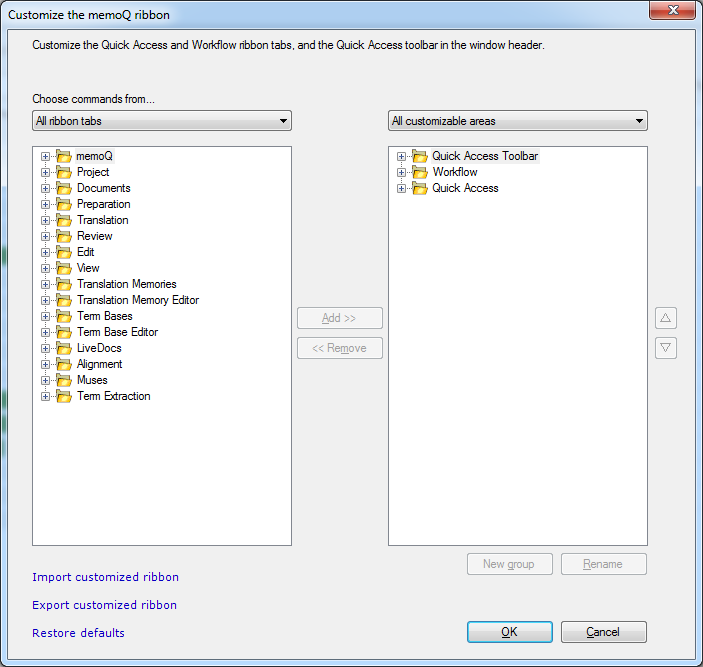|
memoQ has several default ribbon tabs: Project, Documents, Preparation, Translation, Review, Edit, View. Note: If an option is grayed out in a ribbon tab, then the option is not available for the current operation or workflow step. In addition to these, you have a Workflow ribbon tab when you use memoQ in the project manager edition. If you use memoQ in the translator pro edition, you have the Quick Access ribbon tab. Both ribbon tabs contain the most commonly used operations for project managers or translators. However, you can customize the ribbons, e.g. changing the place for an option. Important: You can customize the Quick Access Toolbar, the Quick Access and Workflow ribbon tabs. All other ribbon tabs are not customizable. Example for customizing the Quick Access ribbon tab: Pre-translateBy default, the Pre-Translate command is on the Preparation ribbon tab. Now you would like to have the Pre-Translate command on the Quick Access ribbon tab. Here is how you do this: 1. Click the Customize the Ribbon command on the View ribbon tab. Alternatively, click the Options icon on the Quick Access Toolbar, then go to Appearance. On the Translation grid or Lookup results tab, click Customize the ribbon button. Note: You can also right-click a command into a section in a ribbon tab. The context menu has 3 options: Customize The Ribbon to open the dialog to customize the ribbon; Add To Quick Access Toolbar to add the command that you clicked on, to the Quick Access Toolbar; Minimize the Ribbon to hide the ribbon tabs. Press Ctrl+F1 to expand the ribbon tabs again, or click the arrow icon below the X for closing memoQ. 2. In the Customize the memoQ ribbon list, go to Preparation. This ribbon tab is activated by default. Click the plus icon next to the check mark box. This extends the Preparation ribbon tab sections. 3. Go to Translations. Select Pre-Translate. Click the Add >> button to move the command to a customizable area on the right. Use the << Remove button to remove a command from the customizable area. 4. Use the arrow keys right of the customizable area list, and move a command up or down the place in the ribbon tab accordingly, for example to place the Store section before the Search section on the Quick Access ribbon tab.
5. Click OK to apply the changes. The Store section will now appear after the Search section on the Quick Access ribbon tab. Use the ribbon customization dialog to customize the ribbons. Select commands to either display them or not display them on the ribbon tabs. For example, if you never use the Clipboard section on the Workflow ribbon tab, select the command, then click << Remove. Note: You can move entire sections to be displayed on the ribbon or not - or individual options like the memoQ Web Search. NavigationOn top of the commands list, you can filter the left list for all ribbon tabs, main ribbon tabs or commands. Choose from the Choose commands from drop-down list. If you e.g. choose All commands, then the list will not show the ribbon tabs and sections a command belongs to, only all commands. Filter the customizable area list: All customizable areas which are Quick Access Toolbar, Quick Access and Workflow ribbon tabs or only the Quick Access Toolbar or the Customizable ribbon tabs (Quick Access and Workflow). Click the New Group button to add a new group to a ribbon tab in the customizable area list. Select a command, then click the Rename button to rename a command in the customizable area. Click the Import memoQ ribbon customization link to import a ribbon customization file (XML file), e.g. from another user to use his ribbon tabs view in your memoQ. Click the Export customization link to export your ribbon tab view (as XML file) to share it with your colleague. Click the Reset all ribbon customization to reset all customization and to go back to the default ribbon tabs view. Click OK to apply the ribbon customization. Click Cancel to discard all changes and to close the dialog.
Example for customizing the Quick Access ToolbarCustomize the Quick Access Toolbar. By default, Options, Resource console, Server Administrator and the Help are displayed.
Click the Customize the Ribbon command on the View ribbon tab. The Customize the memoQ ribbon dialog appears. For example, select the Server Administrator command in the Customize the memoQ ribbon dialog, then click the Remove button. The icon will disappear from the Quick Access Toolbar. Or for example, extend the Choose commands from list: View > Ribbon > Customize The Ribbon. Extend the Quick Access Toolbar folder on the right hand side list. Click the Add button to add the Customize The Ribbon command to the Quick Access Toolbar:
You can always open the options in the quick access toolbar from anywhere within memoQ. Compatibility note: memoQ stores ribbon customization data in a memoQ-specific XML file. This file is only created when you start customizing the Quick Access or Workflow ribbon or the Quick Access Toolbar for the first time. When you upgrade memoQ and this upgrade contains changes to the ribbon, your ribbon customizations persist. Changes that were introduced in the upgrade for ribbons will not be shown in the customized sections in the ribbon tabs. If a command was removed from a ribbon tab in the upgrade, then this command will also be removed from your customization. If a command was renamed by Kilgray in the upgrade, then it is removed from the display. However, if you renamed a command in the ribbon tab, then it will remain renamed after the upgrade, unless Kilgray internally changed it. If you click the Restore all ribbon customization link, memoQ restores the default ribbon tab views and deletes the XML customization file.
See also: |
